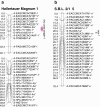Quantitative trait loci in hop (Humulus lupulus L.) reveal complex genetic architecture underlying variation in sex, yield and cone chemistry
- PMID: 23718194
- PMCID: PMC3680207
- DOI: 10.1186/1471-2164-14-360
Quantitative trait loci in hop (Humulus lupulus L.) reveal complex genetic architecture underlying variation in sex, yield and cone chemistry
Abstract
Background: Hop (Humulus lupulus L.) is cultivated for its cones, the secondary metabolites of which contribute bitterness, flavour and aroma to beer. Molecular breeding methods, such as marker assisted selection (MAS), have great potential for improving the efficiency of hop breeding. The success of MAS is reliant on the identification of reliable marker-trait associations. This study used quantitative trait loci (QTL) analysis to identify marker-trait associations for hop, focusing on traits related to expediting plant sex identification, increasing yield capacity and improving bittering, flavour and aroma chemistry.
Results: QTL analysis was performed on two new linkage maps incorporating transferable Diversity Arrays Technology (DArT) markers. Sixty-three QTL were identified, influencing 36 of the 50 traits examined. A putative sex-linked marker was validated in a different pedigree, confirming the potential of this marker as a screening tool in hop breeding programs. An ontogenetically stable QTL was identified for the yield trait dry cone weight; and a QTL was identified for essential oil content, which verified the genetic basis for variation in secondary metabolite accumulation in hop cones. A total of 60 QTL were identified for 33 secondary metabolite traits. Of these, 51 were pleiotropic/linked, affecting a substantial number of secondary metabolites; nine were specific to individual secondary metabolites.
Conclusions: Pleiotropy and linkage, found for the first time to influence multiple hop secondary metabolites, have important implications for molecular selection methods. The selection of particular secondary metabolite profiles using pleiotropic/linked QTL will be challenging because of the difficulty of selecting for specific traits without adversely changing others. QTL specific to individual secondary metabolites, however, offer unequalled value to selection programs. In addition to their potential for selection, the QTL identified in this study advance our understanding of the genetic control of traits of current economic and breeding significance in hop and demonstrate the complex genetic architecture underlying variation in these traits. The linkage information obtained in this study, based on transferable markers, can be used to facilitate the validation of QTL, crucial to the success of MAS.
Figures



References
-
- Hough JS, Howard GA, Slater CA. Bacteriostatic activities of hop resin materials. J Inst Brew. 1957;63:331–333.
-
- Michener HD, Snell N, Jansen EF. Antifungal activity of hop resin constituents and a new method for isolation of lupulon. Arch Biochem Biophys. 1948;19:199–208. - PubMed
-
- Neve RA. Hops. London, UK: Chapman and Hall; 1991.
-
- Shimwell JL. On the relation between staining properties of bacteria and their reaction towards hops antiseptic. J Inst Brew. 1937;43:111–118.
-
- Chen J, Chang SX, Anyia AO. Gene discovery in cereals through quantitative trait loci and expression analysis in water-use efficiency measured by carbon isotope discrimination. Plant Cell Environ. 2011;34:2009–2023. - PubMed
Publication types
MeSH terms
Substances
LinkOut - more resources
Full Text Sources
Other Literature Sources

